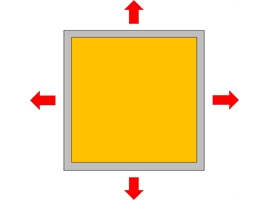How to Guide - Print Registration
Synopsis...
Poor registration between the positive and the print is one area that has caused screen printers problems for years. Unfortunately, there are many factors which can affect dimensional accuracy/reproduction capabilities of the screen print process and often a mis-register in the print is caused by a combination of several factors, making it hard to track down the root cause.
There are three main causes of screen dimensional accuracy problems.
Mechanical – mesh is obviously flexible, therefore if there are any differences in mesh tension from when it was imaged to when it was printed, there will be a difference in size. For example; a thick, multi-layer film positive will cause the mesh to deform around it during vacuuming down for exposure, this will actually stretch the mesh when it is imaged which will then shrink back once the vacuum pressure is released. The same effect can be seen if the frame profile does not allow the mesh to lie perfectly flat against the exposure glass.
Unexpected mesh stretching can also occur if the vacuum blanket is very tacky. In some cases it can actually pull the mesh/stencil outwards as it is vacuumed down. This problem can be identified and subsequently overcome by simply placing a black cloth/card between the mesh and the blanket to break any seal. Although these effects are very small they can cause up to 0.5mm (500µm) distortion over a 1m image.
Mechanical distortion is also caused during the printing process itself, so unless you are printing on-contact then the off-contact distance will cause the image to grow slightly. In most cases for ‘graphics’ images this is not noticeable as long as the off-contact distance remains constant for all the screens used for the job. However, where really accurate image size and placement is required for ‘industrial’ applications, higher tension screens requiring lower off-contact are recommended.
Another possible cause of image distortion is the combination of squeegee pressure and ink characteristics. If the squeegee ‘drags’ across the mesh during printing, or the viscosity of the ink creates significant resistance, the mesh and stencil can become distorted during the print stroke. Careful set-up of the printing press and optimisation of ink viscosity and rheology will address this issue.
Temperature – temperature differences can have a noticeable effect on the size of Aluminium frames, which can then lead to registration problems. For example; a 1m x 1m Aluminium frame is coated, dried at 40°C and then immediately exposed. If it is then allowed to cool to room temperature (20°C) and printed, the frame will have shrunk by 500µm (0.5mm) in both directions. As the image was ‘locked in’ at the higher temperature size the image on the screen at 20°C will be noticeably smaller. The solution to this problem is simple; always expose and print at the same frame temperature. For critical applications maintain the same ambient temperature in the screen making area and the print shop, and allow the frames to return to room temperature after both drying cycles to control this variable.
The film positive itself can be subject to temperature effects, particularly if left on a hot exposure glass before exposure. The changes in dimensions tend to be smaller than the frame but can become a factor for critical applications.
It is not just Aluminium frames and positives that are affected by temperature, many substrates will change size when they are heated, so it is critical that temperature sensitive substrates are pre-shrunk prior to printing and drying. Even ‘stable’ substrates such as Polyester will shrink if they are exposed to high enough temperatures.
Moisture – most substances absorb water, some a lot more than others. As a rule of thumb the more water that a substance absorbs, the more it will expand. Paper is a perfect example, changing size significantly as it picks up, or loses moisture, hence the need to pre-condition paper stocks before printing.
Summary:
As you can see from the above, registration problems are typically caused by differences in tensions, temperatures or moisture contents and can be due to the screen itself or the substrate. There can be differences between screens in a set or between stages in the process. Most of these effects are very small, but they can have an additive effect to cause a noticeable registration difference.
If you are faced with either a screen finishing or registration issue in your print shop, the first thing is to take a step back and look at the whole process, look for these differences and methodically rule out, or control the variables at each stage.




